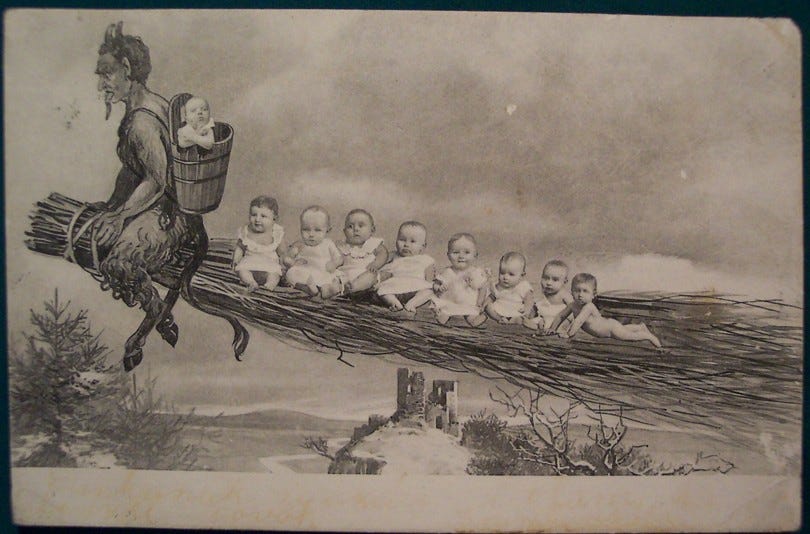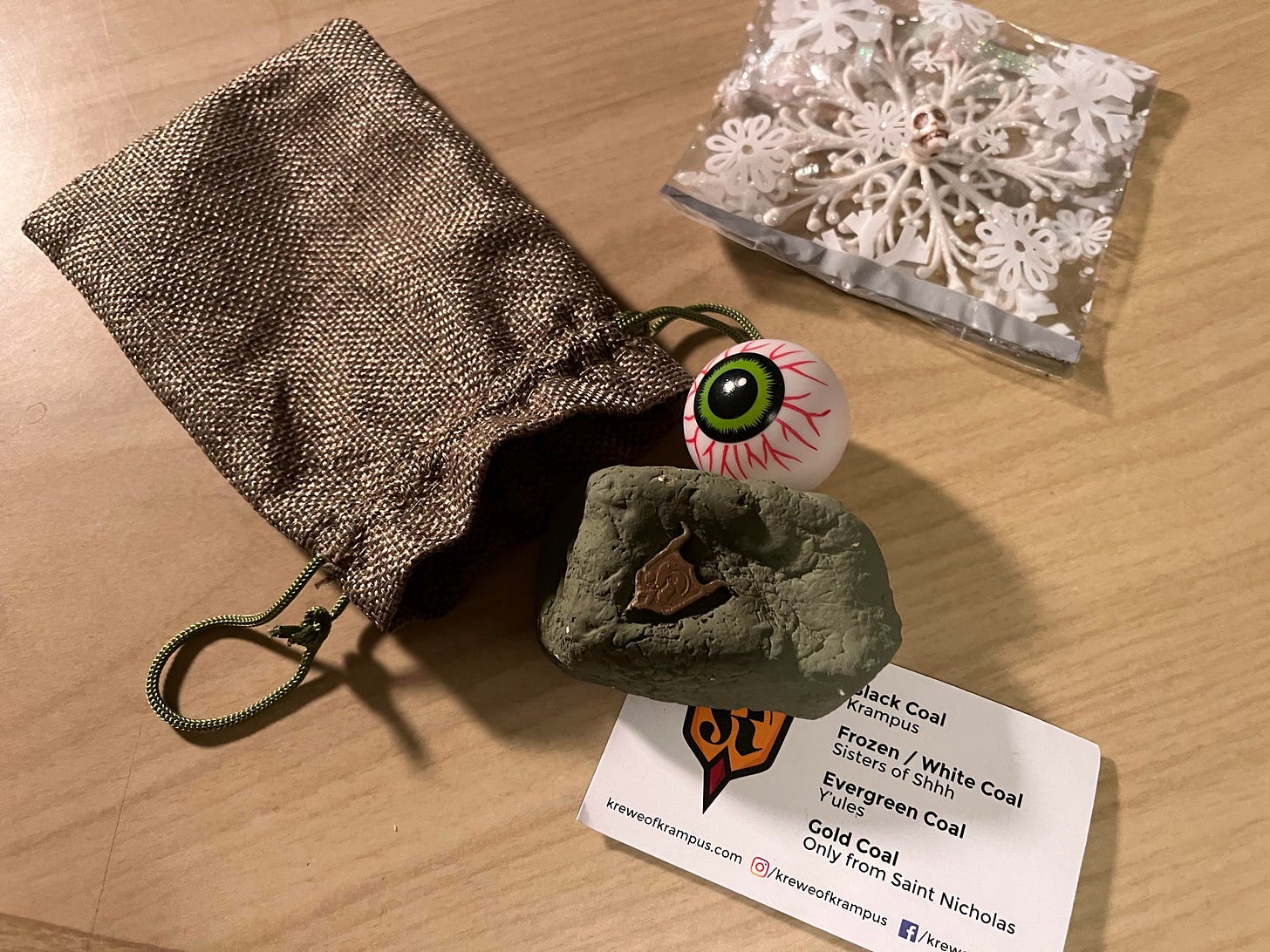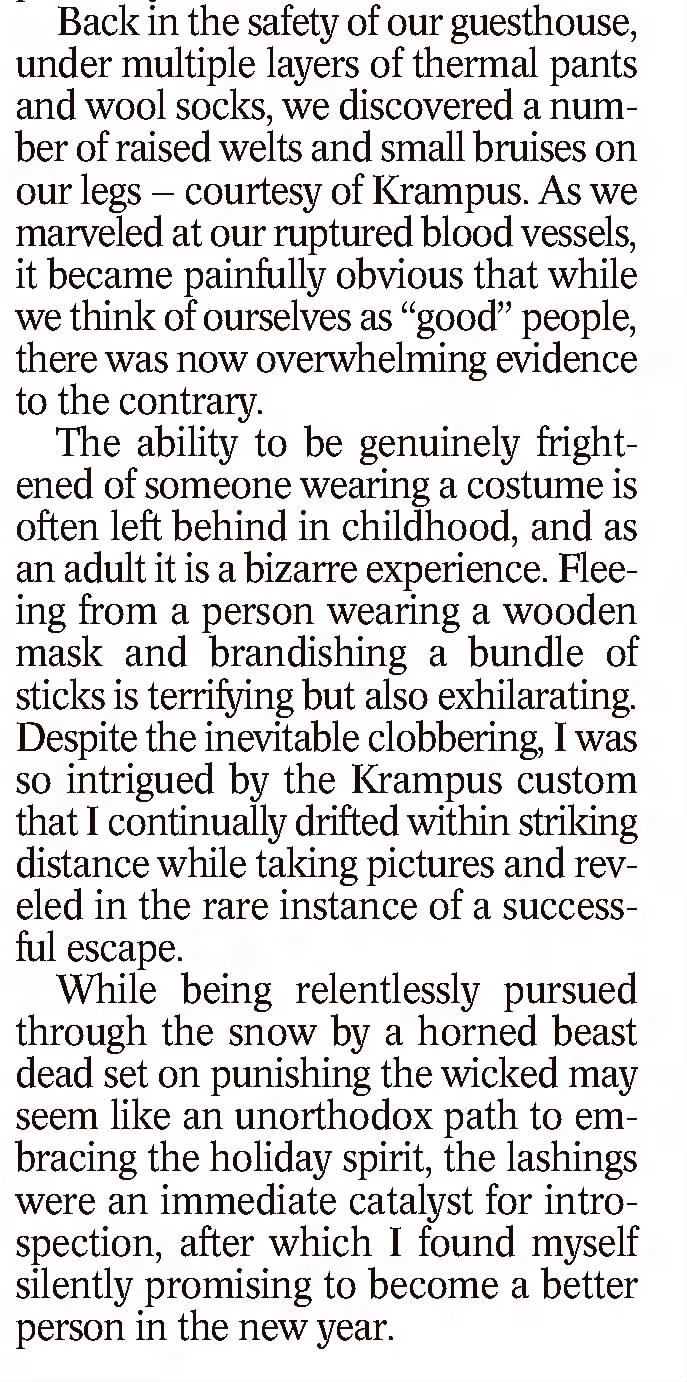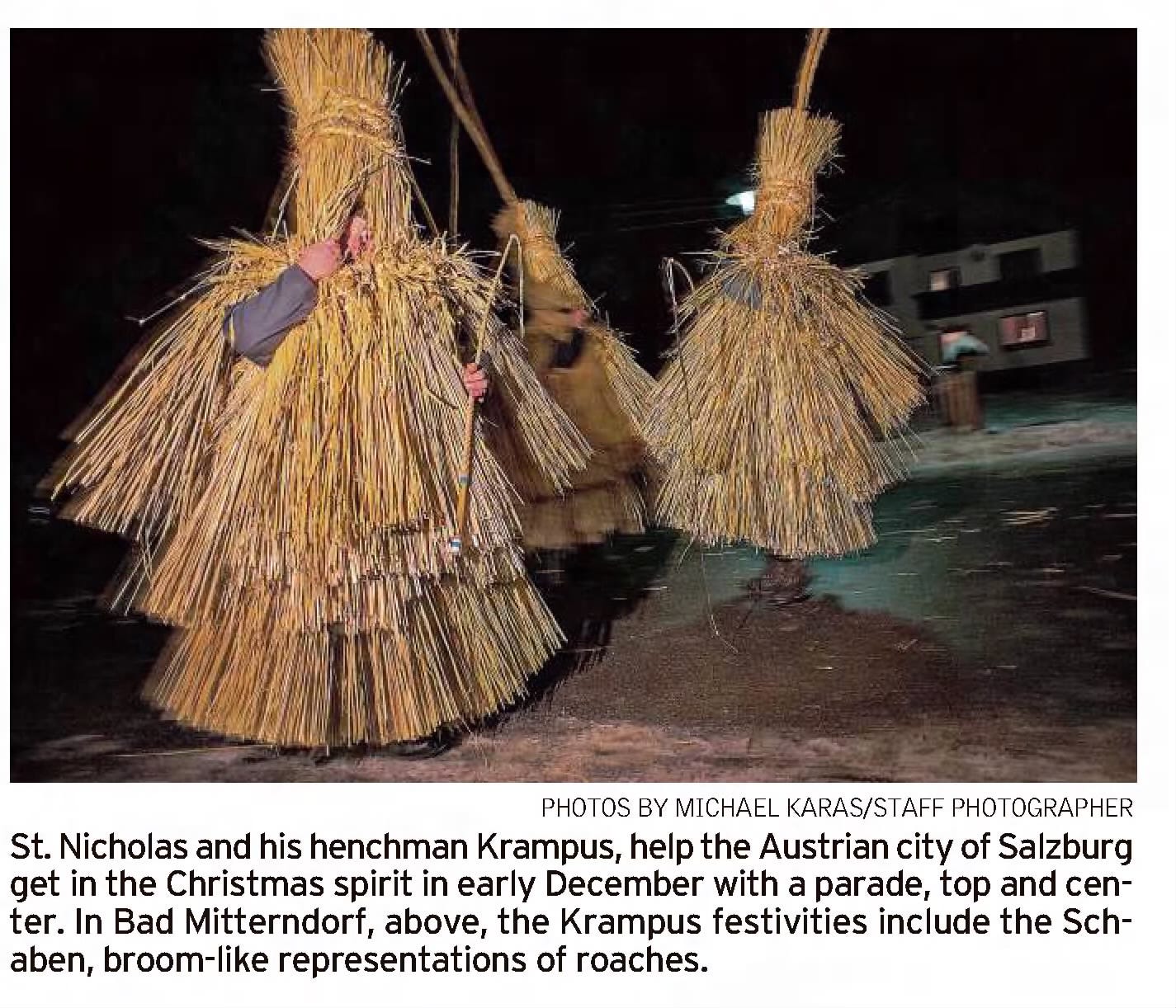Krampus, Swampus, and the Sisters of Shhh
Merry Krampusnacht — or if you prefer, St. Nicholas Eve.

Even if Krampusnacht hadn’t become a smash hit in Philly, Milwaukee, Phoenix, Washington, D.C. and sheesh, even Utah, New Orleans would’ve always staged a Krampus parade. You may not believe me, but I will provide photographic evidence if asked that there are still pumpkins on folks’ porches at this very moment.
That’s not a surprise. What is kind of shocking: a lot of Americans want to mix a little Halloween into their Christmas these days.
If you don’t know anything about Krampusnacht:
In European Alpine folklore, particularly in Germany, St. Nicholas, or Santa Claus, is a cheerful figure who watches over children and brings presents for the good on December 5th, the eve of St. Nicholas's feast day. However, he has a companion known as the Krampus, a demonic figure with goat horns, hooves, and a long slimy tongue, who punishes bad children by beating them with a birch rod and sometimes carrying them away in a basket on his back, either to eat them or take them to hell. Krampus's name comes from the German word, krampen, which is translated as “claw.” Despite the evil characterization, Krampus is not so much a bad figure as one who brings retribution and just punishment for bad behavior. If he does bring “gifts,” they will either be coal or gold-painted birch rods, which parents are meant to leave around the house as a reminder to behave all year long.
In America, it’s traditionally been Santa Claus’s task — a job later farmed out to his lackey, Elf on the Shelf — to keep tabs on everyone, naughty or nice. To add insult to injury here, it appears that Santa doesn’t even bring his own supply of coal, but just grabs a piece out of the fireplace after he lands in your living room.
Of course, getting your own coal for Christmas is nothing compared to being chased by a furry monster and having your butt thwacked with a birch rod. Santa Claus seems like a well-balanced archetype (No fools suffered! No free lunch!) who embodies both mercy and justice. But it’s clear that Santa casts a cold, dark shadow when you see footage of people trampling each other on Black Friday when the automatic doors at their local WalMart open at midnight, or punching each other in the face in the toy aisle after they cross the threshold.
American Capitalism always wants to make one person do the jobs of two, right? Maybe the Medieval Catholics had the right idea when they put St. Nicholas in charge of mercy and Krampus in charge of justice. Either way, I think a lot of people would agree that Christmas feels like weeks of hard work culiminating in a couple of festive days followed by a bunch of less-fun work, including throwing away big piles of wrapping paper, Styrofoam inserts, eggnog cartons and crumpled-up chocolate foils.
As Eric Hoenes del Pinal wrote in his review of Al Ridenour’s 2016 book, The Krampus and the Old, Dark Christmas: Roots and Rebirth of the Folkloric Devil:
Something about this dark figure resonates with people today, leading to a revival of events that just a generation ago were unkindly viewed as rustic provincialisms in Austria, and to their adoption and adaptation by American urbanites….in explaining how Krampus might have first arisen, and why he is experiencing a revival, Ridenour highlights the aspects of fun and play involved in the costumed krampuslauf. Terror may be the primary mood that the Krampus evokes, but one can’t ignore the ludic quality that underscores his visits. Explanations about the rituals that highlight their magical elements, he says, tend to occlude the very real fun that participants derive from dressing up and running amok. The point of a Krampustroop’s visit to a farmstead is never to actually harm children, but rather, to enact a sort of morality play that both edifies and entertains. The fear that Krampus may engender is done in the context of play, and krampuslaufs tend to be raucous and carnivalesque affairs featuring plenty of drinking, flirting, and general carousing. This is a good reminder that rituals need not be solemn affairs, and that the pleasure they generate for participants is as important a motivator for participation as any other.
In New Orleans, a lump of coal is a good thing
Last Saturday, we stood on Royal Street in a light rain to watch our very first Krewe of Krampus NOLAuf, (currently the largest Krampus run in the United States). To my shock, I ended up with throws despite wearing boring street clothes. The guy to my right brought it; he looked like a Vegas showgirl version of Krampus. And all along the street, there were horns: deer horns, ram horns, antlers strung with LED lights, horns attached to baseball caps. There was face paint in every color. There were sparkles and glitter and skirts with petticoats strung with Christmas lights. Honestly, the krewe just felt sorry for me, I’m sure.
“Ashes to ashes and dust to dust. Here’s a lump of coal,” a man from the Y’ule troupe said to me, pushing a tiny burlap sack into my hands. Later, upon opening it, I discovered a lump of “evergreen coal,” marked with a tiny gold K.
For those who aren’t familiar with New Orleans parades: you probably know they throw beads, but the really good parades hand out hand-made throws themed to the parade. The Krewe of Krampus “selected something you typically do not want to get in your stocking” — coal. But TKoK makes its coal by hand, so each one is a little piece of art.
As you can probably tell from the photo, the “coal” is sculpted; TKofK invented materials it dubbed Krampus Clay and Gl’ule, both made from pulverized, recycled glass. If I’d actually been motivated enough to wear a costume, I discovered I could’ve gone home with all four lumps of coal, incuding gold coal from St. Nicholas and “frozen coal,” from the Sisters of Shh.
There’s a Queen of Shh — I’m not 100 percent which one she was — but the effect of watching a procession of icy-looking ladies walking down Royal in complete silence was eerie and beautiful. Despite being Nancy Normcore, one of them pulled a silver snowflake out of her basket and put it in my hand. No frozen coal this year, but I’m happy to make the acquaintance of the Sisters of Shhh:
Traditionally, in Alpine countries, Krampus costumes are worn by men and most of the legends that showcase women feature them as old hags. Deciding that this wouldn’t work a modern legend was born. A character was created that merged nature with the idea of a female version of Krampus. Thus, the Queen of Shhh was born. Cloaked all in icy white to symbolize winter she is a figure to be feared. Like Krampus she can lure the naughty away or frighten them back onto a path of good behavior, but the one thing she always does is warn all that Krampus is coming. Shhh stands for SHe Harkens Him and when you see the women all in white you know Krampus is not far behind.
By the way, the correct plural for Krampus is not “Krampi,” but “Krampusse.” I wondered about that word as I watched them all cavorting down the street: big ones, small ones, brown ones, gray ones, frosty white ones, all with baskets and bells and scary masks and big horns. One Krampus, running late, cut through a break in the crowd near us; as we politely stood out if its way, it nodded in appreciation that we’d made room for its quite-large presence, wagging the bells on its butt and dancing near us. Before it bounced down the street, it gave me a plastic eyeball, which I think means Krampus is always watching you. We’ll keep that eyeball on our mantel to remind us to mind our Ps and Qs in 2024.
American Krampusse are still not as intense as their German counterparts, as this travel writer for The Record discovered in 2014:
The Krewe of Krampus created a troupe that’s specific to New Orleans — Swampus — to explain why Krampusse are here in Louisiana when their natural habitat is the Alps. (It involves the story of a particularly naughty kid, Fritz Schütz.)
Based on the account of that Record writer, I think the Krewe of Krampus overlooked an absolutely crucial part of traditional Krampus parades that must be added to NOLAuf in the future to reflects an important piece of our local heritage and local ecosystem: strohschabe, or straw cockroaches.
Unruly Santas and other holiday delights
One of my favorite annual holiday reads is this 1995 police report describing the San Francisco PD apprehension of a crew of anarchic Santas. These Santas, affiliated with the Bay Area Cacophony Society, acted “in a very un-Christmaslike manner,” according to officer Jeff Barry. Read it and decide for yourself!
By the by, file this under “everything loops back on itself”: Al Ridenour, author of the Krampus book mentioned above, once romped with the L.A. Cacophonists under the moniker “Rev. Al.”
If you missed the Krampuslauf in your town last weekend, there may yet still be some Krampus-related fun happening. If you live in New Orleans, note that our love of Halloween means there’s another way you can celebrate Krampusnacht: at a Krampus-themed haunted house, where you can get your pic taken with Krampus, mall-Santa style.
Hope you have a merry Krampusnacht, a mild St. Nicholas Eve, or just pass the day in calm, wintery peace without a single thought of an archetype passing through your head — however you choose to spend your December 5.
Before I bow out, a shake of the bells to new subscribers Sally B., Black Dog Bone, Our Little Sins, Kim C., Ellie, Hubeth, and Ismailalilou.








Informative, evocative, and great fun. A tip of the hat to the krewe!